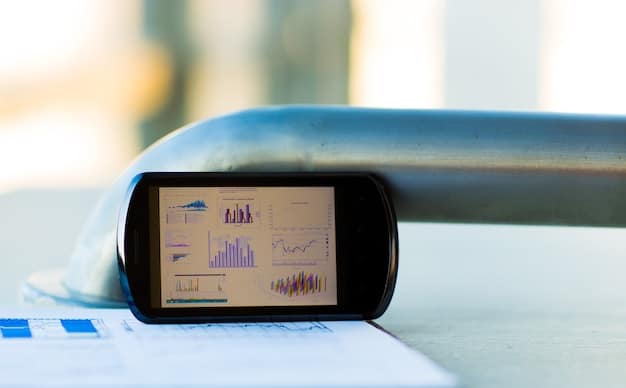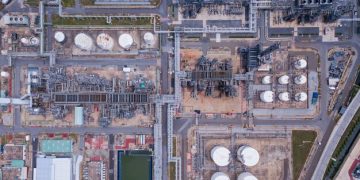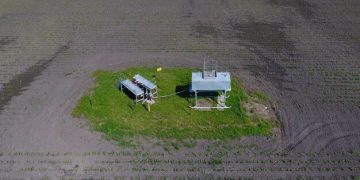Smart Sensors Revolutionizing US Infrastructure: Leak Detection & Prevention

US infrastructure upgrades are increasingly integrating smart sensor technology to detect and prevent leaks, enhancing efficiency and sustainability in water, gas, and other critical systems.
The integration of smart sensors in US infrastructure upgrades: integrating smart sensors for leak detection and prevention, marks a pivotal advancement in safeguarding critical resources and ensuring the longevity of essential systems. These technologies offer real-time monitoring and data analysis, leading to proactive leak detection and reduced environmental impact.
Understanding the Need for Infrastructure Upgrades in the US
Aging infrastructure poses significant challenges to the United States, with frequent leaks and failures leading to resource wastage and potential safety hazards. Addressing these issues requires innovative solutions that enhance the efficiency and resilience of existing systems.
The State of US Infrastructure
The American Society of Civil Engineers (ASCE) consistently gives US infrastructure a low grade, citing issues such as aging pipelines, inadequate maintenance, and increasing demands on resources. This necessitates urgent and comprehensive upgrades.
Impact of Leaks on Resources and the Environment
Leaks in water and gas pipelines lead to significant losses, impacting both the economy and the environment. Water scarcity is exacerbated by undetected leaks, while gas leaks contribute to greenhouse gas emissions.
- Economic losses due to wasted resources.
- Environmental damage from gas leaks and water contamination.
- Increased risk of infrastructure failure and safety hazards.
Investing in infrastructure upgrades is not merely a matter of maintenance; it’s a proactive step towards ensuring the sustainable management of vital resources and the safety of communities nationwide. By addressing the root causes of leaks and failures, the US can build more resilient and efficient infrastructure for the future.

Smart Sensor Technology: An Overview
Smart sensor technology offers a sophisticated approach to monitoring infrastructure, providing real-time data and analytics. These sensors enable proactive leak detection and prevention, minimizing resource wastage and environmental impact.
How Smart Sensors Work
Smart sensors are equipped with advanced capabilities to measure various parameters, such as pressure, temperature, and flow rate. This data is then transmitted wirelessly to a central monitoring system for analysis.
Types of Smart Sensors Used in Infrastructure
Different types of sensors are employed depending on the specific application, including acoustic sensors for detecting leaks in pipelines, and electrochemical sensors for monitoring water quality.
Smart sensor technology represents a paradigm shift in infrastructure management. By providing continuous, real-time data, these sensors enable operators to identify and address potential issues before they escalate into major failures, thereby improving the overall efficiency and reliability of critical systems.
Benefits of Integrating Smart Sensors for Leak Detection
Integrating smart sensors into US infrastructure yields numerous benefits, from early leak detection to improved resource management and reduced environmental impact. These advantages contribute to a more sustainable and resilient infrastructure system.
Early Leak Detection and Reduced Response Time
Smart sensors can detect leaks early, often before they become visible, allowing for faster intervention and minimizing the amount of resources lost.
Improved Resource Management and Conservation
By detecting and preventing leaks, smart sensors help conserve valuable resources, such as water and natural gas, ensuring more efficient utilization.
- Real-time monitoring improves leak detection accuracy.
- Proactive maintenance reduces long-term repair costs.
- Data-driven decision-making enhances overall efficiency.
The integration of smart sensors is a strategic investment in the future of US infrastructure. By embracing these technologies, the nation can safeguard its resources, protect the environment, and build a more sustainable and resilient infrastructure system that meets the needs of future generations.

Case Studies: Successful Implementation in the US
Several successful case studies in the US demonstrate the effectiveness of smart sensors in detecting and preventing leaks in various infrastructure systems. These examples highlight the real-world benefits and potential for wider adoption.
Water Pipeline Monitoring in California
California has implemented smart sensor technology to monitor its extensive water pipeline network, resulting in significant reductions in water loss and improved water management.
Natural Gas Leak Detection in Urban Areas
Cities like Boston have deployed smart sensors to detect natural gas leaks, enhancing safety and reducing greenhouse gas emissions in densely populated urban areas.
Challenges and Solutions
While the benefits are clear, implementing smart sensor technology also presents challenges, such as data management, cybersecurity concerns, and integration with existing infrastructure. Addressing these challenges requires careful planning and collaboration.
These case studies provide valuable insights into the successful implementation of smart sensor technology for leak detection. By learning from these experiences, other regions can effectively adopt and adapt these solutions to their specific infrastructure needs, contributing to a more resilient and sustainable future.
Challenges and Considerations for Widespread Adoption
Despite the numerous benefits, widespread adoption of smart sensors in US infrastructure faces several challenges. Addressing these considerations is crucial for successful implementation and long-term sustainability.
Cost of Implementation and Maintenance
The initial cost of deploying smart sensor technology can be a barrier for some municipalities. However, long-term savings from reduced leaks and improved efficiency often outweigh the upfront investment.
Data Management and Cybersecurity
Managing and securing the vast amount of data generated by smart sensors is essential. Robust cybersecurity measures are needed to protect against potential threats.
- Addressing initial costs through government incentives and grants.
- Developing standardized protocols for data management.
- Investing in cybersecurity infrastructure to protect sensitive data.
Overcoming these challenges requires a collaborative effort from government agencies, technology providers, and infrastructure operators. By addressing these considerations proactively, the US can pave the way for the widespread adoption of smart sensor technology and unlock its full potential for improving infrastructure resilience and sustainability.
The Future of Infrastructure Management with Smart Sensors
The future of infrastructure management in the US is increasingly reliant on smart sensor technology. Advancements in sensor technology and data analytics promise even greater efficiency, sustainability, and resilience.
Advancements in Sensor Technology
Emerging technologies, such as nanotechnology and artificial intelligence, are enhancing the capabilities of smart sensors, enabling more accurate and predictive monitoring.
Predictive Maintenance and Proactive Interventions
By analyzing data from smart sensors, infrastructure managers can predict potential failures and intervene proactively, preventing costly repairs and disruptions.
The integration of smart sensors is transforming infrastructure management from a reactive to a proactive approach. By leveraging these technologies, the US can build a more resilient, efficient, and sustainable infrastructure system that meets the needs of future generations and contributes to a healthier environment.
| Key Point | Brief Description |
|---|---|
| 💧 Leak Detection | Smart sensors enable early detection of leaks in pipelines. |
| 💰 Resource Conservation | Reduces wastage of valuable resources like water and gas. |
| 📊 Data Analytics | Enhances decision-making with real-time data analysis. |
| 🛡️ Cybersecurity | Focus on protecting data and infrastructure from threats. |
FAQ
▼
Smart sensors are devices equipped with microprocessors that can measure physical properties like pressure, temperature, and flow, and transmit this data for analysis.
▼
Smart sensors detect leaks by monitoring pressure changes, acoustic signals, and flow rates in pipelines, alerting operators to potential issues.
▼
Benefits include early leak detection, reduced resource wastage, proactive maintenance, and improved overall efficiency in infrastructure management.
▼
Challenges include high initial costs, cybersecurity risks, data management complexities, and integrating new technology with existing infrastructure systems.
▼
The future involves more advanced sensors, predictive maintenance, and smarter infrastructure management, leading to increased sustainability and resilience.
Conclusion
The integration of smart sensors into US infrastructure upgrades: integrating smart sensors for leak detection and prevention represents a transformative approach to resource management and infrastructure resilience. By embracing these technologies, the US can safeguard its resources, protect the environment, and build a more sustainable and efficient future.





